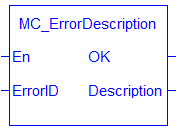![]()
![]()
 Function
Function![]() A function calculates a result according to the current value of its inputs. A function has no internal data and is not linked to declared instances. - Converts the PLCopen
A function calculates a result according to the current value of its inputs. A function has no internal data and is not linked to declared instances. - Converts the PLCopen![]() A vendor -and product- independent worldwide association active in Industrial Control and aiming at standardizing PLC file formats based on XML error IDs into message strings.
A vendor -and product- independent worldwide association active in Industrial Control and aiming at standardizing PLC file formats based on XML error IDs into message strings.
Inputs
|
Input |
Data Type |
Range |
Unit |
Default |
Description |
|---|---|---|---|---|---|
|
En |
BOOL |
0, 1 |
N/A |
No default |
If TRUE, this function converts the ErrorID to a string message. |
|
ErrorID |
INT |
0, 69 |
N/A |
No default |
Error ID generated from a PLCopen function block. See the table in PLCopen Function Block ErrorIDs. |
Outputs
|
Output |
Data Type |
Range |
Unit |
Description |
|---|---|---|---|---|
|
OK |
BOOL |
0, 1 |
N/A |
If TRUE, the command completed successfully. |
|
Description |
STRING |
No range |
N/A |
String error description. |
Remarks
- See Function Blocks - General Rules for more information about how inputs and outputs work.
- Return a text description corresponding to a motion control
 Motion control is a sub-field of automation, in which the position and/or velocity of machines are controlled using some type of device such as a hydraulic pump, linear actuator, or an electric motor, generally a servo. Motion control is an important part of robotics and CNC machine tools; however, it is more complex than in the use of specialized machines, where the kinematics is usually simpler. The latter is often called General Motion Control (GMC). Motion control is widely used in the packaging, printing, textile and assembly industries error ID code.
Motion control is a sub-field of automation, in which the position and/or velocity of machines are controlled using some type of device such as a hydraulic pump, linear actuator, or an electric motor, generally a servo. Motion control is an important part of robotics and CNC machine tools; however, it is more complex than in the use of specialized machines, where the kinematics is usually simpler. The latter is often called General Motion Control (GMC). Motion control is widely used in the packaging, printing, textile and assembly industries error ID code. - The message strings can be used for display or logging.
Figure 6-114: MC_ErrorDescription
FBD Language Example
FFLD Language Example
IL Language Example
Not available.
ST Language Example
Description:= MC_ErrorDescription(ErrorID);









